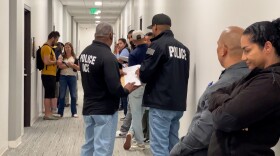When Tau Baraka was growing up, southeastern San Diego was already a pretty diverse community. Baraka, now 47 and the owner of Imperial Barbershop in Encanto, said that back then the area was primarily white, African American and Hispanic.
“But as the years start progressing, you start seeing a big change in that, especially with the Filipino population here,” Baraka said.
Why Diversity Matters
Politicians and local organizations often commend diverse communities for their inclusiveness and multi-ethnic character. But measuring real diversity is a nuanced and sometimes imperfect science.
Now, neighborhoods in southeastern San Diego, including Encanto, Paradise Hills and Skyline, are home to sizable Filipino, Samoan, and West and East African populations. An inewsource analysis of 2010 census data found that Encanto is the most diverse community in San Diego.
INTERACTIVE: Searchable map of diversity in San Diego neighborhoods
When many people hear the word diversity, they tend to think “minorities.” But the diversity index used in the inewsource analysis gives the term new perspective.
Think about it like this: What are the chances you’ll walk out of your house and run into someone of a different race and ethnicity? If the chances are high, your neighborhood is diverse.
For example, Encanto has a diversity index of .81. That means there’s an 81 percent chance that you’ll randomly run into someone of a different race and ethnicity.
A low score on the diversity index doesn’t necessarily mean a community is mostly white. San Ysidro has a diversity index of just .30. It’s an overwhelmingly minority neighborhood with a 93 percent Hispanic population.
The increasing diversity of San Diego’s southeastern neighborhoods doesn’t surprise John Weeks, director of the International Population Center at San Diego State University. Historically, areas east of downtown have had a mix of low rents and close proximity to jobs in the city’s center, Weeks said. That combination made those neighborhoods attractive to new immigrants.
What has followed, Weeks said, is what is known as the pioneer effect. That’s when a small group of immigrants moves into a city or neighborhood where no one of their race lives. These “pioneers” open shops and restaurants, selling goods and food from back home. That attracts more people from their home country to that same neighborhood.
“When you have an unusual concentration, then that provides the likely spot where people will live because the pioneer migrants are already there,” Weeks said. “It’s a little bit easier to get adjusted to life in the United States in an area where you know the people who are like you are already living.”
Baraka saw that happen first hand with the Filipino population in Paradise Hills. When he was in high school in the early 1980s, the Filipino community in southeastern San Diego was small. Now, he says it’s so big it attracts not just Filipinos but also Samoans.
Less Diversity At The Coast
If the eastern part of San Diego is the most diverse, the coast is the most homogenous. And in this case, homogenous does mean mostly white.
Point Loma, Ocean Beach and La Jolla are among the least diverse neighborhoods in the city. Ocean Beach, for example, is 80 percent white and has a diversity index of just .24. That makes it the fifth least diverse community in San Diego.
Weeks said that cost of living drives the diversity makeup there.
“The coast has become so expensive that in order to live there you’ve got to have a lot of money,” Week said. “And at this moment in time, the majority of people that have a lot of money that can afford to live on the coast tend to be white non-Hispanics.”
Most coastal neighborhoods are around 80 percent non-Hispanic white. The only non-coastal communities with such high concentrations of a single racial and ethnic group are some small communities near Fairbanks Ranch and San Ysidro.
Weeks thinks that as incomes rise in the diverse eastern parts of San Diego, those residents will also move out to the coast. That could lead to a more balanced map of diversity in the region.
The Diversity Index
For this analysis, we looked at diversity as a balance of racial and ethnic groups, not just the presence of specific minorities. To achieve that we used a diversity index developed by journalists at USA Today. The index provides a number between 0 and 1, with the higher numbers indicating greater diversity.
The index allows for more accurate comparisons of diversity across neighborhoods. However, the census data can sometimes underestimate the diversity in a neighborhood, SDSU’s Weeks said.
Take, for example, Iraqi immigrants in San Diego. Weeks said that although they represent a distinct ethnic group, they don’t show up that way in census data that set diversity categories in the 19th century.
When the census asks those Iraqi immigrants to describe themselves they likely mark themselves as not Hispanic and white, Weeks said. However, culturally and ethnically they are different from the European descendants most associated with non-Hispanic whites. That lack of nuance, Weeks said, can make it hard “to spot that type of diversity in the community.”
Despite limitations of the data used to calculate the diversity index, the index provides a unique way of looking at specific neighborhoods.
Baraka sees that diversity every day at his Encanto barbershop.
“You go outside these doors you see the world walking past. You sit here long enough you see the world coming in,” he said.





